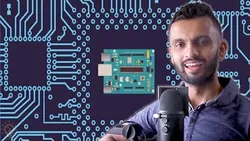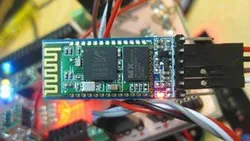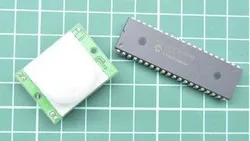
AVR microcontrollers: C language electronic devices 
Explore the world of AVR microcontrollers and gain practical experience in programming electronic devices using the C language. This course is designed for both beginners and experienced electronics engineers, offering in-depth knowledge of microcontroller functions, I&O pins, ADC, PWM, EEPROM, timers, and more, with a focus on interfacing with various external devices and sensors. Get a comprehesive understanding of this course which is a cost course. AZ Class provides this course data for free. Learn more certificate and details here. ▼
ADVERTISEMENT
Course Feature
![]() Cost:
Cost:
Paid
![]() Provider:
Provider:
Udemy
![]() Certificate:
Certificate:
Paid Certification
![]() Language:
Language:
English
![]() Start Date:
Start Date:
On-Demand
Course Overview
❗The content presented here is sourced directly from Udemy platform. For comprehensive course details, including enrollment information, simply click on the 'Go to class' link on our website.
Updated in [October 18th, 2023]
What does this course tell?
(Please note that the following overview content is from the original platform)
AVR microcontrollers: I&O ADC PWM etc Programming microcontroller C language practical work Atmega XMEGA series
What youll learn:
Microcontrollers AVR: I&O pins PWM ADC EEPROM timers etc
Microcontroller structure and Programming Introduction
C Programming Basics C language for AVR
Business projects using AVR microcontroller
LEDs and Pushbuttons
LCD Screens and Seven Segment Displays
Motor and Keypad
Analog to Digital Conversion
Timers and Counters
Wireless devices controlled by AVR
Attention! All earned funds will go to support the Ukrainian army in the fight against Russian invaders
This course is for beginner and advanced electronics engineers who want to gain and increase experience in developing embedded systems on AVR microcontrollers I think that AVR ATMEL microcontrollers are the most advanced 8-bit microcontrollers All ARDUINO projects are built by using these microcontrollers After completing the course the student will receive the necessary knowledge about I&O ports ADC PWM EEPROM timers interrupts Much attention in this course will be paid to interfaces with external devices - sensors wireless devices real time clocks external EEPROM etc We will take a look the UART (USART) serial interface SPI interface TWI (two wire interface) the connection by 1-wire bus The course will consider connections to the microcontroller of various devices - display devices (LED 7-segment LED displays LCD) matrix keyboards and so on Students will get the experience of programming AVR microcontroller on C language This course includes business projects also
Finished codes
sources of this projects I will send students in private messages
The course shows complete programs and videos of working devices Work projects will be included in this course also This training course is constantly expanding Feedback with students Individual lessons and project support
I kindly ask you to carefully read the curriculum and description of the course and do not make purchases with the aim of further refund The course contains enough material in the public domain for you to appreciate the presentation style Sorry my english isnt nice))
We considered the value of this course from many aspects, and finally summarized it for you from two aspects: skills and knowledge, and the people who benefit from it:
(Please note that our content is optimized through artificial intelligence tools and carefully reviewed by our editorial staff.)
What skills and knowledge will you acquire during this course?
During this course on AVR microcontrollers, the student will acquire the following skills and knowledge:
1. Understanding of microcontroller structure and programming introduction.
2. Proficiency in C programming basics and C language for AVR microcontrollers.
3. Knowledge of I&O pins, PWM (Pulse Width Modulation), ADC (Analog to Digital Conversion), EEPROM (Electrically Erasable Programmable Read-Only Memory), timers, and counters.
4. Ability to work with various external devices such as sensors, wireless devices, real-time clocks, and external EEPROM.
5. Familiarity with interfaces like UART (USART) serial interface, SPI interface, TWI (two-wire interface), and 1-wire bus connection.
6. Experience in connecting and programming display devices such as LED, 7-segment LED displays, and LCD screens.
7. Proficiency in programming AVR microcontrollers using C language.
8. Understanding of business projects using AVR microcontrollers.
9. Knowledge of working with LEDs, pushbuttons, motors, keypads, and analog to digital conversion.
10. Ability to develop wireless devices controlled by AVR microcontrollers.
11. Access to finished codes and sources of projects, which will be sent to students in private messages.
12. Exposure to complete programs and videos of working devices.
13. Inclusion of work projects in the course.
14. Constantly expanding training course with feedback and individual lessons.
15. Support for projects throughout the course.
Please note that the funds earned from this course will go towards supporting the Ukrainian army in their fight against Russian invaders.
Who will benefit from this course?
This course will benefit beginner and advanced electronics engineers who want to gain and increase experience in developing embedded systems on AVR microcontrollers. It is specifically designed for individuals interested in working with AVR ATMEL microcontrollers, which are considered the most advanced 8-bit microcontrollers. The course covers various topics such as I&O pins, PWM, ADC, EEPROM, timers, interrupts, and interfaces with external devices like sensors, wireless devices, real-time clocks, external EEPROM, display devices (LEDs, 7-segment LED displays, LCD), and matrix keyboards.
The course also includes business projects and provides finished codes and sources of these projects. Students will gain experience in programming AVR microcontrollers using the C language. The course is constantly expanding and offers feedback with students, individual lessons, and project support.
Course Provider

Provider Udemy's Stats at AZClass
Discussion and Reviews
0.0 (Based on 0 reviews)
Explore Similar Online Courses

The Vision of Leadership: How to Build a Social Mission-Driven Brand

MongoDb with Python

Python for Informatics: Exploring Information

Social Network Analysis

Introduction to Systematic Review and Meta-Analysis

The Analytics Edge

DCO042 - Python For Informatics

Causal Diagrams: Draw Your Assumptions Before Your Conclusions

Whole genome sequencing of bacterial genomes - tools and applications

Fun and Easy Microcontroller Communication Protocols

Bluetooth module Interfacing with PIC Microcontroller


Start your review of AVR microcontrollers: C language electronic devices